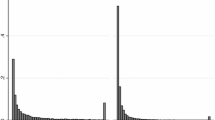Abstract
Foreign direct investment is thought to contribute to host economies by increasing their efficiency either directly or through technology diffusion. Such efficiency benefits are neither equally produced by foreign firms nor equally distributed to all domestic firms. The special question addressed in this study is related to how differentiated such effects are depending on size and degree of (foreign) ownership. Based on a sample of 3,742 manufacturing firms operating in Greece in 1997, it is found that, while it is large, majority-held foreign firms that exhibit higher productivity, spillovers are important for small domestic firms and stem mostly from small joint ventures where the foreign partner owns a minor part of equity. JEL no. F23, O30
Similar content being viewed by others
References
Aitken, B. J., and A. E. Harrison (1999). Do Domestic Firms Benefit from Direct Foreign Investment?, Evidence from Venezuela.American Economic Review 89 (3): 605–618.
Baldwin, J. (1996). Productivity Growth, Plant Turnover and Restructuring in the Canadian Manufacturing Sector. In D. Mayes (ed.),Sources of Productivity Growth, Cambridge, Mass.: Cambridge University Press.
Barbosa, N., and H. Louri (2002). On the Determinants of Multinationals' Ownership Preferences: Evidence from Greece and Portugal.International Journal of Industrial Organization 20 (4): 493–515.
Barrell, R., and N. Pain (1997). Foreign Direct Investment, Technological Change, and Economic Growth within Europe.Economic Journal 107 (November): 1770–1786.
Barrios, S., S. Dimelis, H. Louri, and E. Strobl (2002). Efficiency Spillovers from Foreign Direct Investment in the EU Periphery: A Comparative Study of Greece, Ireland and Spain. Fundacion de Estudios de Economia Aplicada, DP Series 2002-02, Madrid.
Blomström, M. (1986). Foreign Investment and Productive Efficiency: The Case of Mexico.Journal of Industrial Economics 35 (1): 97–110.
Blomström, M., and A. Kokko (1998). Multinational Corporations and Spillovers.Journal of Economic Surveys 12 (3): 247–277.
Blomström, M., and F. Sjöholm (1999). Technology Transfer and Spillovers: Does Local Participation with Multinationals Matter?European Economic Review 43 (4/6): 915–923.
Blomström, M., A. Kokko, and S. Globerman (2001). The Determinants of Host Country Spillovers from Foreign Direct Investment: A Review and Synthesis of the Literature. In N. Pain (ed.),Inward Investment, Technological Change and Growth: The Impact of Multinational Corporations on the UK Economy. Basingstoke: Palgrave.
Caballero, R. (1997).Aggregate Investment. NBER Working Paper 6264. National Bureau of Economic Research, Cambridge, Mass.
Cantwell, J. (1993). Technological Competence in Evolving Patterns of International Production. In H. Cox, J. Clegg, and G. Letto-Giles (eds.),The Growth of Global Business, London: Routledge.
Caves, R. E. (1996).Multinational Enterprise and Economic Analysis. Cambridge, Mass.: Cambridge University Press.
Chhibber, P., and S. Majumdar (1999). Foreign Ownership and Profitability: Property Rights, Control, and the performance of Firms in Indian Industry.Journal of Law and Economics 42, (1): 209–238.
Cleeve, E. (1997). The Motives for Joint Ventures: A Transaction Costs Analysis of Japanese MNE's in the UK.Scottish Journal of Political Economy 44 (1): 31–43.
Conyon, M., S. Girma, S. Thompson, and P. Wright (2002). The Productivity and Wage Effects of Foreign Acquisition in the United Kingdom.Journal of Industrial Economics 50 (1): 85–102.
Davies, S., and B. Lyons (1991). Characterising Relative Performance: The Productivity Advantage of Foreign Owned Firms in the UK.Oxford Economic Papers 43 (4): 584–595.
Dimelis, S., and H. Louri (2002). Foreign Ownership and Production Efficiency: A Quantile Regression Analysis.Oxford Economic Papers 54 (3): 449–469.
Driffield, N. (2001). The Impact on Domestic Productivity of Inward Investment in the UK.Manchester School 69 (1): 103–119.
Girma, S., D. Greenaway, and K. Wakelin (2001). Who Benefits from Foreign Direct Investment in the UK?Scottish Journal of Political Economy 48 (2): 119–133.
Globerman, S., J. Ries, and I. Vertinsky (1994). The Economic Performance of Foreign Affiliates in Canada.Canadian Journal of Economics 27 (1): 143–156.
Görg, H., and E. Strobl (2001). Multinational Companies and Productivity Spillovers: A Meta-Analysis.Economic Journal 111 (November): 723–739.
Griffith, R. (1999). Using the ARD Establishment Level Data to Look at Foreign Ownership and Productivity in the United Kingdom.Economic Journal 109, (June): 416–442.
Haddad, M., and A. Harrison (1993). Are There Positive Spillovers from Direct Foreign Investment?Journal of Development Economics 42 (1): 51–74.
Hubbard, G. (1998). Capital Market Imperfections and Investment.Journal of Economic Literature 36 (1): 193–225.
Intrilligator, M., R. Bodkin, and C. Hsiao (1996).Econometric Models, Techniques, and Applications. New York: Prentice Hall.
Kokko, A. (1994). Technology, Market Characteristics and Spillovers.Journal of Development Economics 43 (2): 279–293.
Kokko, A., M. Zejan, and R. Tansini (2001). Trade Regimes and Spillover Effects of FDI: Evidence from Uruguay.Review of World Economics/Weltwirtschaftliches Archiv 137 (1): 124–149.
Markusen, J. (1995). The Boundaries of Multinational Enterprises and the Theory of International Trade.Journal of Economic Perspectives 9 (Spring): 169–189.
Markusen, J., and A. Venables (1999). Foreign Direct Investment as a Catalyst for Industrial Development.European Economic Review 43 (2): 335–356.
Mayers, D. (ed.) (1996).Sources of Productivity Growth. Cambridge, Mass. Cambridge University Press.
Nakamura, M., and J. Xie (1998). Nonverifiability, Noncontractibility and Ownership Determination Models in Foreign Direct Investment, with an Application to Foreign Operations in Japan.International Journal of Industrial Organisation 16 (5): 571–599.
Nickell, S., and D. Nicolitsas (1999) How Does Financial Pressure Affect Firms?European Economic Review 43 (8): 1435–1456.
Nickell, S., S. Wadhani, and M. Wall (1992). Productivity Growth in U.K. Companies, 1975–1986.European Economic Review 36 (5): 1055–1091.
Oulton, N. (1998).Labour Productivity and Foreign Ownership in the UK. NIESR Working Paper 143. National Institute of Economic and Social Research, London.
Saunders, R. (1980). The Determinants of Productivity in Canadian Manufacturing Industries.Journal of Industrial Economics 29 (2): 167–184.
Sjöholm, F. (1999a) Productivity Growth in Indonesia: The Role of Regional Characteristics and Direct Foreign Investment.Economic Development and Cultural Change 47 (3): 559–584.
Sjöholm, F. (1999b). Technology Gap, Competition and Spillovers from Direct Foreign Investment: Evidence from Establishment Data.Journal of Development Studies 36 (1): 53–73.
Wang, Y., and M. Blomström (1992). Foreign Investment and Technology Transfer: A Simple Model.European Economic Review 36 (1): 137–155.
Author information
Authors and Affiliations
Corresponding author
About this article
Cite this article
Dimelis, S., Louri, H. Foreign direct investment and technology spillovers: Which firms really benefit?. Rev. World Econ. 140, 230–253 (2004). https://doi.org/10.1007/BF02663647
Issue Date:
DOI: https://doi.org/10.1007/BF02663647



